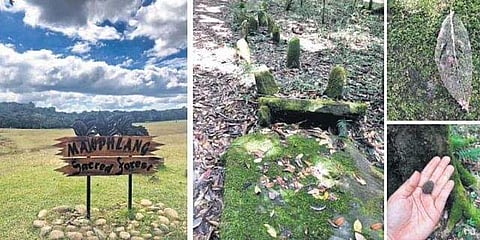
- LIFESTYLE
- FASHION
- FOOD
- ENTERTAINMENT
- EVENTS
- CULTURE
- VIDEOS
- WEB STORIES
- GALLERIES
- GADGETS
- CAR & BIKE
- SOCIETY
- TRAVEL
- NORTH EAST
- INDULGE CONNECT

Much before religion became institutionalised in the world, the Pagan gods of the forested hills and valleys, rivers, and mountains presided over the cycles of life. A case no different in India, they prospered in sacred forests such as the Mawphlang Sacred Grove, an hour’s drive from Shillong, Meghalaya. A smooth tarmac road with views of the rolling hills on either side delivers you to its start point where you can hire a few guides for the rest of the journey. It was around noon when I reached the grove. It looked cool and inviting. A trail has been cut out through the dense foliage. The frequent rains had made little furrows on the ground.
Moss and mushroom covered the barks of ancient trees. It is a wonderland that has been preserved marvellously by the locals. The Mawphlang Sacred Grove is no ordinary forest, being among India’s most popular sacred groves which are protected by the communities living around it. They believe it is the home of spirits, and carrying away even a leaf from the forest is a travesty, which could lead to dire consequences. Monoliths, seating places and resting places now covered in moss indicate flourishing rituals of days past. The forest is full of stories, as if each time the leaves rustle, they are whispering its folk lore. Some of the trees in the grove are believed to be over a thousand years old. Some are known to have medicinal properties. Even today, once a year, the male members of the Mawphlang village of Khasi tribals who preserve the grove visit a designated spot to conduct rituals which involve an animal sacrifice. Acceptance of the sacrifice is considered a good omen. Many villages here have their own sacred grove usually under the care of the tribal leader of that village. Mawphlang continues to be the biggest of them, covering about 192 acres of land.
As I navigated the slippery trail with crisscrossing streams and reached deeper, my guide quizzed me, “Have you ever used Zandu Balm?” Without waiting for my answer, he plucked a leaf from a tree, crumbled it between his fingers and handed it over. It did smell like the famous balm. A few hundred steps later he says, “Did you know rudraksha is the seed of a fruit that grows on this tree?” And he pointed at a very tall tree soaring into the sky. He had hidden a few rudraksha beads in the crevices for his clients to touch and feel. “Keep them back. Ill health will follow if you take anything out of this forest...” are his warning words. From time to time as the wind gushed, leaves and petals showered down on me and my Khasi guide, creating a frisson of unnamed excitement.
The sacred groves are not superstition. What seems far removed from modern conveniences and scientific advancement is a promise to protect Nature and local culture. Because trees of Mawphlang are considered sacrosanct, not a single one is felled or a single creature harmed in the groves. The streams and tarns are undisturbed too. There are many such groves in India. Theyyam in Kerala, devrais in Maharashtra, nagamandala in Karnataka, orans in Rajasthan, and devbans in Himachal Pradesh.
These unspoilt forest spaces are biodiversity hotspots where various rare species thrive in harmony. The inhabitants believe that the gods live in forests, preventing political and real estate interests from raiding and destroying the green sanctuaries. Their deities take the shapes of leopards or tigers to protect localities and grant its residents wishes. Faith and healing happen here in these patches of primaeval forests. This stress on the great ancient system of reverence for nature could very well be the most hopeful and effective way to protect what remains of the ecologically devastated planet.